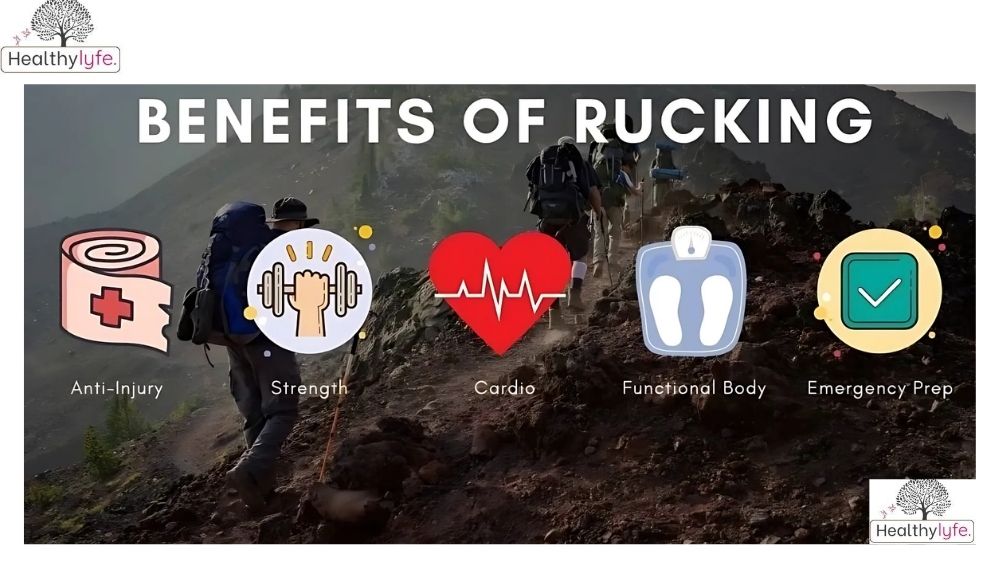Rucking is a simple, low-impact exercise for weight loss. Burn calories, build strength, and boost endurance by walking with a weighted backpack.
Introduction
If you’re looking for an easy and effective way to lose weight, rucking is a great choice. It’s simply walking with a weighted backpack, which boosts the intensity of your walk and helps you burn more calories. Rucking not only helps with weight loss but also strengthens your muscles, improves endurance, and is gentle on your joints. In this blog, we’ll explain why rucking is one of the best exercises for weight loss and how you can get started.
What is Rucking?

Rucking is a simple but effective workout that involves walking with a weighted backpack. Originally used by military personnel to build strength and endurance, it’s now become a popular fitness activity for people of all fitness levels. By adding weight to your walk, rucking increases the intensity, helping you burn more calories and strengthen muscles, especially in your legs, back, and core. It’s an easy-to-do, low-impact exercise that can be done almost anywhere, making it a great addition to any fitness routine.
Types of Rucking
Rucking can be adjusted to suit different fitness goals and preferences. Here are some common types of rucking you can try:
- Standard Rucking
This is the basic form of rucking, where you walk with a weighted backpack on flat ground. It’s a great full-body workout that builds endurance, strengthens muscles, and helps with weight loss. - Hilly Rucking
For an added challenge, you can ruck on hilly or uneven terrain. Walking uphill adds more resistance and engages your muscles even more, especially in your glutes, calves, and core. - Interval Rucking
This type of rucking involves alternating between brisk walking and slower walking to increase the intensity. For example, walk at a fast pace for 3 minutes, then slow down for 1 minute. This method boosts your calorie burn and improves cardiovascular fitness. - Rucking with Weight Variations
You can mix up your rucking routine by changing the weight in your backpack. Start with a lighter load and gradually increase the weight to keep challenging your muscles and boosting the intensity. - Rucking with Sprints
For a more intense workout, add short sprints into your rucking routine. After walking for a few minutes, sprint for 20-30 seconds, then resume your normal pace. This is a great way to combine rucking with cardio training for fat loss. - Rucking with Training or Obstacle Courses
Some ruckers add challenges like bodyweight exercises (e.g., squats, lunges) or obstacle courses while rucking. This type of rucking enhances strength and adds variety to your routine.
Benefits of Rucking Exercise [1]
Rucking is more than just a simple walk with a weighted backpack—it’s a full-body workout that offers a wide range of health benefits. Whether you’re looking to lose weight, improve cardiovascular health, or increase strength, rucking can help you achieve your fitness goals. This low-impact, high-intensity exercise is accessible to people of all fitness levels and can be done almost anywhere. In this article, we’ll explore the key benefits of rucking and why it should be a part of your fitness routine.
Helps with Weight Loss
By adding weight to your walk, rucking increases the number of calories you burn compared to regular walking. The additional resistance challenges your muscles and boosts your metabolism, making it an effective exercise for fat loss. Rucking helps you burn calories both during the workout and in the hours after, thanks to the muscle-building effects.
Builds Muscle and Strength
Rucking engages multiple muscle groups, including your legs, core, and back. Carrying a weighted pack helps build muscle, especially in your glutes, quads, hamstrings, and calves. The added resistance also strengthens your core and upper body as you maintain balance while walking.
Improves Cardiovascular Health
Rucking is an excellent cardiovascular workout. The increased heart rate from carrying weight helps improve heart health over time, boosting endurance and stamina. As a low-impact exercise, it’s gentler on the joints compared to running, making it suitable for people of all ages and fitness levels.

Low-Impact on Joints
Unlike high-impact exercises like running, rucking is much gentler on your joints, which makes it a great option for people with joint pain or those who are recovering from an injury. The movement is natural and doesn’t put unnecessary strain on your knees, hips, or ankles, so you can do it more frequently without risking injury.
Increases Endurance and Stamina
Rucking improves your stamina and overall endurance by conditioning your body to handle physical exertion over time. As you ruck regularly, your body adapts, and you can walk longer distances at a faster pace, helping you build endurance for other activities as well.
Enhances Mental Well-Being
Like other forms of exercise, rucking can help reduce stress and anxiety. The rhythmic movement of walking, combined with the physical challenge, can be very meditative and calming. Spending time outdoors and enjoying nature while rucking also contributes to better mental health.
Convenient and Accessible
Rucking doesn’t require a gym membership or fancy equipment—just a backpack and some weight. You can do it anywhere: in your neighborhood, on hiking trails, or even in parks. It’s a cost-effective workout that fits easily into your lifestyle.
Diet Plan for Rucking
Rucking is a demanding exercise that requires proper nutrition to fuel your body, build endurance, and aid recovery. Whether you’re rucking to lose weight, build strength, or improve fitness, following a balanced diet is essential. Here’s a sample diet plan to help you perform your best during rucking workouts.
Key Nutrition Tips for Rucking
- Focus on Protein: Helps repair and strengthen muscles.
- Choose Healthy Carbs: Provides energy for long rucks.
- Stay Hydrated: Prevents fatigue and improves performance.
- Include Healthy Fats: Supports sustained energy release.
- Don’t Skip Recovery Foods: Helps muscles recover after rucking.
Sample Diet Plan for Rucking
| Meal | Food Options |
|---|---|
| Breakfast | Oatmeal with banana and almond butter, boiled eggs, or a protein smoothie with spinach and berries. |
| Mid-Morning | Greek yogurt with honey, a handful of nuts, or a granola bar. |
| Lunch | Grilled chicken or fish with quinoa, steamed veggies, and avocado slices. |
| Afternoon Snack | Apple with peanut butter, trail mix, or a protein shake. |
| Dinner | Lean protein (like turkey or salmon), sweet potatoes, and roasted vegetables. |
| Post-Ruck Snack | Chocolate milk, a protein bar, or a small bowl of cottage cheese with fruits. |
Additional Tips for Rucking Nutrition
- Pre-Ruck Meal: Eat a balanced meal 1-2 hours before your ruck. Focus on carbs and protein for energy.
- During Ruck: For long rucks, carry water or an electrolyte drink. A small snack like a banana or energy bar can help during breaks.
- Post-Ruck Recovery: Eat within 30–60 minutes of finishing your ruck. A mix of protein and carbs is ideal for recovery.
- Meal Timing: Spread your meals evenly throughout the day to maintain energy levels.
Tips for Success
Rucking is a versatile and rewarding workout, but like any exercise, doing it right is key to seeing results and avoiding injuries. Whether you’re a beginner or an experienced rucker, these tips will help you get the most out of your rucking routine.
Start Light and Build Gradually
- Begin with a lightweight backpack (10-15 pounds) and gradually increase the weight as you get stronger.
- Avoid starting too heavy, as it can strain your muscles and joints.
Invest in Good Gear
- Use a sturdy, comfortable backpack with padded straps to protect your shoulders.
- Wear quality walking or hiking shoes with good support to prevent foot discomfort.
Maintain Proper Posture
- Keep your back straight, shoulders relaxed, and core engaged.
- Avoid leaning forward too much, as this can cause back strain.
Choose the Right Terrain
- Start on flat surfaces and gradually progress to hills or trails for a greater challenge.
- Mixing up terrains keeps your routine interesting and works different muscle groups.
Stay Hydrated
- Carry water with you during longer rucks to stay hydrated.
- Drinking plenty of water before and after your ruck helps prevent fatigue.
Warm Up and Cool Down
- Do a 5-10 minute warm-up (like light walking or dynamic stretches) before starting.
- Stretch after your ruck to reduce muscle soreness and improve flexibility.
Listen to Your Body
- Pay attention to signs of discomfort or fatigue. Rest if needed to avoid overexertion or injury.
- Gradually increase your pace and distance to avoid pushing yourself too hard too soon.
Track Your Progress
- Use a fitness tracker or app to monitor your distance, pace, and calories burned.
- Set goals and celebrate milestones to stay motivated.
Pair with a Balanced Diet
- Eat nutrient-rich foods to fuel your body and aid recovery (see the rucking diet plan above).
- Focus on protein, healthy carbs, and hydration for optimal performance.
Stay Consistent
- Aim to ruck at least 2-3 times per week to build endurance and see results.
- Consistency is the key to making progress and reaping the benefits of rucking.
Conclusion
Rucking is a simple, effective workout that helps you lose weight, build strength, and improve fitness. By walking with a weighted backpack, you burn more calories, strengthen your muscles, and boost your endurance—all without putting stress on your joints. It’s easy to start, affordable, and works for all fitness levels. Whether you’re aiming to shed pounds, get stronger, or enjoy a fun outdoor activity, rucking is a great choice.
FAQs about Rucking
What is rucking?
Rucking is walking with a weighted backpack. It’s a simple, low-impact exercise that burns calories, builds strength, and improves endurance.
Is rucking good for weight loss?
Yes, rucking is excellent for weight loss. The added weight increases calorie burn compared to regular walking.
How much weight should I carry while rucking?
Beginners should start with 10-15% of their body weight and gradually increase as they build strength.
Do I need special equipment for rucking?
You need a sturdy backpack, weights (like sandbags or plates), and comfortable walking shoes.
How often should I ruck?
You can ruck 2-3 times a week to start. Adjust frequency based on your fitness goals and recovery.
Is rucking better than running?
Rucking burns fewer calories than running but is lower impact, making it better for people with joint issues or beginners.
What muscles does rucking work?
Rucking strengthens your legs, glutes, core, and back. Carrying weight also engages your shoulders and upper body.
Can I ruck indoors?
Yes, you can ruck on a treadmill or around large indoor spaces, though outdoor rucking is more common and enjoyable.
How far should I ruck?
Start with 1-2 miles and increase the distance as you build stamina. Advanced ruckers often cover 5-10 miles.
Is rucking safe for everyone?
Rucking is generally safe, but people with existing injuries or health conditions should consult a doctor first.
Does rucking hurt your back?
If done correctly with proper posture and appropriate weight, rucking strengthens your back rather than harming it.
Can rucking replace other workouts?
Rucking can complement your workout routine but might not fully replace strength training or cardio for some goals.
What should I eat before rucking?
A meal with carbs and protein, like oatmeal with nuts or a banana with peanut butter, provides energy for your ruck.
What’s the best terrain for rucking?
Flat ground is great for beginners, while hills and trails add variety and challenge for advanced ruckers.
How do I avoid injuries while rucking?
Start with light weight, wear proper footwear, maintain good posture, and avoid overloading your backpack.
Can rucking improve mental health?
Yes, like other forms of exercise, rucking reduces stress, boosts mood, and provides a sense of accomplishment.
What’s the ideal pace for rucking?
A brisk walking pace (15-20 minutes per mile) is ideal for most people. Adjust based on your fitness level.
Can I ruck with friends?
Absolutely! Rucking with friends or in groups makes it more enjoyable and motivating.
What’s a good backpack for rucking?
Look for a durable backpack with padded straps, a hip belt, and space for weights. Some brands specialize in rucking gear.
Can rucking help build muscle?
Yes, rucking helps build muscle, especially in your legs, core, and back, due to the resistance from carrying weight.
By healthylyfe


